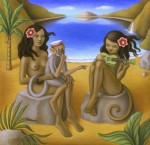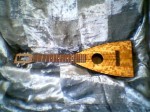Videos this week from Kelli Rae Powell, The Jack Lords, Mark Occhionero and many more.
Kelli Rae Powell – Some Bridges are Good to Burn Read the rest of this entry »
Videos this week from Kelli Rae Powell, The Jack Lords, Mark Occhionero and many more.
Kelli Rae Powell – Some Bridges are Good to Burn Read the rest of this entry »
There’s a new book in the Jumpin’ Jim/Lyle Ritz Ukulele Masters series just out: Lyle Lite. As the name suggests, it’s aimed a little lower than his other books at the beginner/intermediate level. You can pick one up from FMM for $25, on Amazon for $18.80 (but they’re currently out of stock), or there’s one on eBay with a Buy It Now of $17.70 (and a hefty delivery charge).
It’s not often you get a chance to pick up one of KoAloha‘s Signature Series Tenor Sceptre. According to their blog, they’re back ordered up the wazoo. But MGM has one up for sale at the moment.
A couple of very interesting Tangi ukuleles: a playable, scale model ten and a half inch ukulele and a violin shaped uke.
Dave Gjessing of WaverlyStreet ukuleles has a painted pineapple uke with a nautical design by the Artful Dodger up for sale.
I’m back a little early. There’s news to be newsed. Over the break I had to take the fancy rotating banner off the front of the site. It was bringing the whole site crashing down every couple of weeks so it had to go. It was very pretty but a whole heap of trouble (like a few girls I could mention).
Windy City Ukulele Festival details.
I’ve had a few people ask me various questions about playing with others and in uke groups but – being an anti-social loner who avoids human contact at all costs – I’ve never been much help to them. Now I can point them towards Play Well With Others. It’s a book and website giving advice on jamming which boasts endorsements from Janet Klein, Jim Beloff and Lil Rev. It’s also a handsome looking site.
 Amy Crehore is selling 50 signed prints of ‘The Creature’. You can pick up yours here.
Amy Crehore is selling 50 signed prints of ‘The Creature’. You can pick up yours here.
Seeso and Clara Belle featured on Boing Boing (thanks for the mention, Seeso).
MP3s: I’ve mentioned foggy ruins of time many times in this section. The guy behind it has released an EP, under the name Existential Hero, featuring his bariuke. You can download the whole thing here. songs:illinois has Jenny Jenkins.
Uke chords on posters: officially a good idea. Shelley ‘Uke Box’ Rickey features Kokomo on her poster (and some not safe for work material – what is it with ukes and nudity?)
Paul McCartney reprises his ukulele version of Something at the Anfield gig plus a quick burst of When I’m Washing [sic] Windows.
Isaac was a little disappointed not to win Ukulele Review’s contest and came up with this (inspired by Cyanide and Happiness). Click to enlarge.
Vote for the song you want Fin Raucous to play in his shed.
Rebekulele: a cross between a ukulele and a rebec.
COMPETITION CLOSED
I’m jumping on the ukulele giveaway bandwagon and starting up a competition. The prizes are:
First prize: A Kala Pineapple soprano courtesy of ukulele for sale.
Ten Runners Up: One of my ukulele ebooks (your choice).
Everyone Who Enters Gets: Tab for my solo arrangement of Rick Astley’s Never Gonna Give You Up (yeah, you read right).
What you have to do: Review your ukulele.
You can write it, make a video, take pictures, record an mp3, whatever takes your fancy. I’ll put it up on the Buy a Ukulele section so everyone can benefit from your experience. The winner will be the one I find most interesting and enlightening (it doesn’t matter whether you give the ukulele a good review or a bad review; or if the uke cost $10 or $10,000).
Email me with your entry (or, if you make a video, upload it to a video sharing site and send me the url). If you want me to link to your website/blog/Facebook/MySpace when I put it on the site, include that too.
The Rules
The review has to be new and original.
You don’t mind me putting it on the site.
You can enter once per ukulele.
Competition Closes: Midnight (Hawaii time) 6th July.
Before we get down to business, James Hill’s new website/ezine Ukulele, Yes! is up and running. I still haven’t managed to successfully sign up for the ezine itself, but it looks like it’s all online anyway. A bunch of good stuff in the first issue including an interview with Peter Luongo, , an arrangement of Rattle on the Stovepipe (splatters and squiggles only) and an article by John Kavanagh about me (there might be something about Ragtime in there as well).
With the new Indiana Jones film coming out and a couple of requests for it, I thought I’d take a stab at arranging it for the uke. To be honest, I didn’t think it would work on the uke. I’ve been trying to do a decent arrangement of Star Wars for the uke but haven’t come up with anything good enough. The Indiana Jones theme is similarly epic, John Williams stuff. But, with a bit of jumping around and finger twisting, it works pretty well. Make sure you let as many notes ring into each other as you can to get a extra sound out of it.
There’s a simplified version of this tab here
This week’s videos include Seeso, Janet Klein, James Hill and many more.
 First off: if you’re in the UK and looking to buy a Fluke, friend of the blog, Gary is selling his Mango Fluke (right).
First off: if you’re in the UK and looking to buy a Fluke, friend of the blog, Gary is selling his Mango Fluke (right).
These four Oscar Schmidt OU2 with a busted bridge. I mentioned another Oscar Schmidt with a broken bridge not long ago. It does make me wonder if this is a common problem with the Oscar Schmidts.
I’m not too interested in this Liberty ukulele (particularly not at $800). But what a fantastic box.
If the Formby/Harrison ukuleles are a bit out of your range, there’s an “Abbot” Monarch ukulele for sale on eBay UK for a measly £6,000 (for that price tag, you’d expect them to spell ‘Abbott’ correctly).
George Formby’s Abbott Monarch “Little Strad” banjolele (as used for recording When I’m Cleaning Windows along with many others) is up for auction at Bonhams in London next month. The estimate is £45,000 (via BBC). Also up for sale is a Dallas E banjolele formerly owned by both Formby and George Harrison (via Uncut).
Bosko and Honey talk about their Ukulele Safari on Ukulele Spotlight (mp3 link).
After a bit of lull with the Tribute to REM season, Le Soir is back on top form with decent performances from famous people like Get Cape, Wear Cape, Fly and The Wombats; and great sessions from people I’ve never heard of like Timesbold and Cocoon.
There’s still a little time to enter Ukulele Review’s logo contest and plenty of time to enter ukulele for sale video contest.
St Matthew Passion on the Ukulele(MP3 link).*
Does the size of your ukulele stop you showing it to a girl? UPDATE: He should read the Dating Advice from Ukulele Players (includes Uke Hunt faves Jen Kwok and Sweet Soubrette).
Chords for Queen’s Dont Stop Me Now courtesy of Andy.
*I spent so long working this one out the moment has long gone, still…
I have to admit that, since I featured her first uke video way back when, I’ve neglected Julia Nunes. Truth be told, I’m still a little on the fence about her. Nevertheless, there’s no denying the charm of this version of Build Me Up, Buttercup.
These chords are the Nunes version, but they’re very similar to the original version by The Foundations (they’re both in the key of C).
Mad Tea Party – Found A Reason (mp3)
Mad Tea Party – Bunny Moves On (mp3) via Nine Mile Records
Mad Tea Party are a very fun band with catchy songs and the sound of a ukulele crashing up against rollocking guitar riffs and rockabilly licks. Judging by the preview tracks put out by Nine Mile Records, their forthcoming album, Found A Reason, looks set to be their best yet.
The core of the band is ukulelist and vocalist Ami Worthen and guitarist Jason Krekel. They got together in 2004 and have put out three albums to date. Nick Beery made a documentary about them and you can watch the whole film on his blog. They (along with, bassist at the time, Lora Pendelton) make quite an eccentric bunch. If you haven’t got an hour to spare, the choice quote from Ami is, “I’m not going for the record deal, the MTV. I want to play the ukulele, and I think if I had a manager and I was on that path, one of the first things they’d tell us is to ditch the ukulele.”
Found A Reason will be released in June. Visit their website.